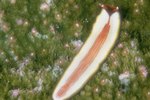
Roundworms do not breathe in the sense that vertebrates, such as humans and other mammals, do. Instead, roundworms (also known as nematodes) obtain the oxygen their bodies need through diffusion, a process of gas exchange commonly used among flatworms and earthworms as well. Diffusion allows roundworms to provide oxygen to their cells without the use of complex organs, such as lungs.
Roundworm Simplicity
In terms of their anatomy, roundworms are simplistic. They lack skeletons, blood vessels, lungs, even a brain. They do have a digestive system that is as long as their bodies. However, the system is linear with food coming into the mouth and traveling in a straight line through the pharynx and intestines, then out through the anus. They also lack a circulatory system, and their nervous system consists only of two cords of nerve cells that send messages through the worm's body. Considering the simplicity of their anatomy, we should not be surprised that roundworms lack a respiratory system and rely on a more simplistic gas exchange process to take in oxygen.
Diffusion: A General Definition
In science, diffusion refers to the movement of molecules from an area where they are highly concentrated into an area where they are less concentrated. For example, the molecules in a lump of sugar added to water will spread apart in the water because they can be less concentrated in the water than they were in the sugar cube. As a result, the sugar lump dissolves in the water. Diffusion occurs in the human body, too. For example, oral medication diffuses once it enters the stomach so the active ingredients move from the highly concentrated area inside the capsule into the less concentrated area of the stomach and eventually the bloodstream.
Roundworm Diffusion
Like earthworms, roundworms use diffusion to supply their bodies with oxygen. In these organisms, diffusion takes place through the worm’s skin. Roundworms take in oxygen through their skin, then those molecules are diffused through their bodies and into their cells -- essentially the oxygen goes to parts of the body where less oxygen is present. When the cells use the oxygen, they produce carbon dioxide, which builds up in a high concentration that is diffused back through the skin into the environment where it can be less concentrated.
Suspension of Diffusion
If a human’s respiratory system stops functioning, the person is in real trouble without immediate medical attention. With some roundworms, however, their respiratory system and other bodily functions can stop without causing any harm to the organism. In fact, the stoppage might actually protect the roundworm. According to the University of California at Berkeley, some species of nematodes can enter cryptobiosis, which is a period when all of their bodily processes are suspended, usually because the worm finds itself in an unfavorable living environment. When the environment takes a turn for the better, the roundworm's processes, including diffusion, start up again.
References
- Monroe County Women's Disability Network: Roundworms
- Fulton County Schools: Nematode Information
- McGraw Hill: Human Anatomy - How Diffusion Works
- Laboratory for Scientific Visual Analysis: Diffusion and the Human Body
- University of Pennsylvania: Diffusion - Allowing Earthworms to Breathe
- Biology Resources: Diffusion
- University of California at Berkeley: Introduction to the Nematoda
- Honors Biology: Roundworms
Photo Credits
-
Duncan Smith/Stockbyte/Getty Images
Writer Bio
Amy Jorgensen has ghostwritten more than 100 articles and books on raising and training animals. She is also an amateur dog trainer. She has also written more than 200 blog posts, articles, and ebooks on wedding and party planning on behalf of professionals in the field.




